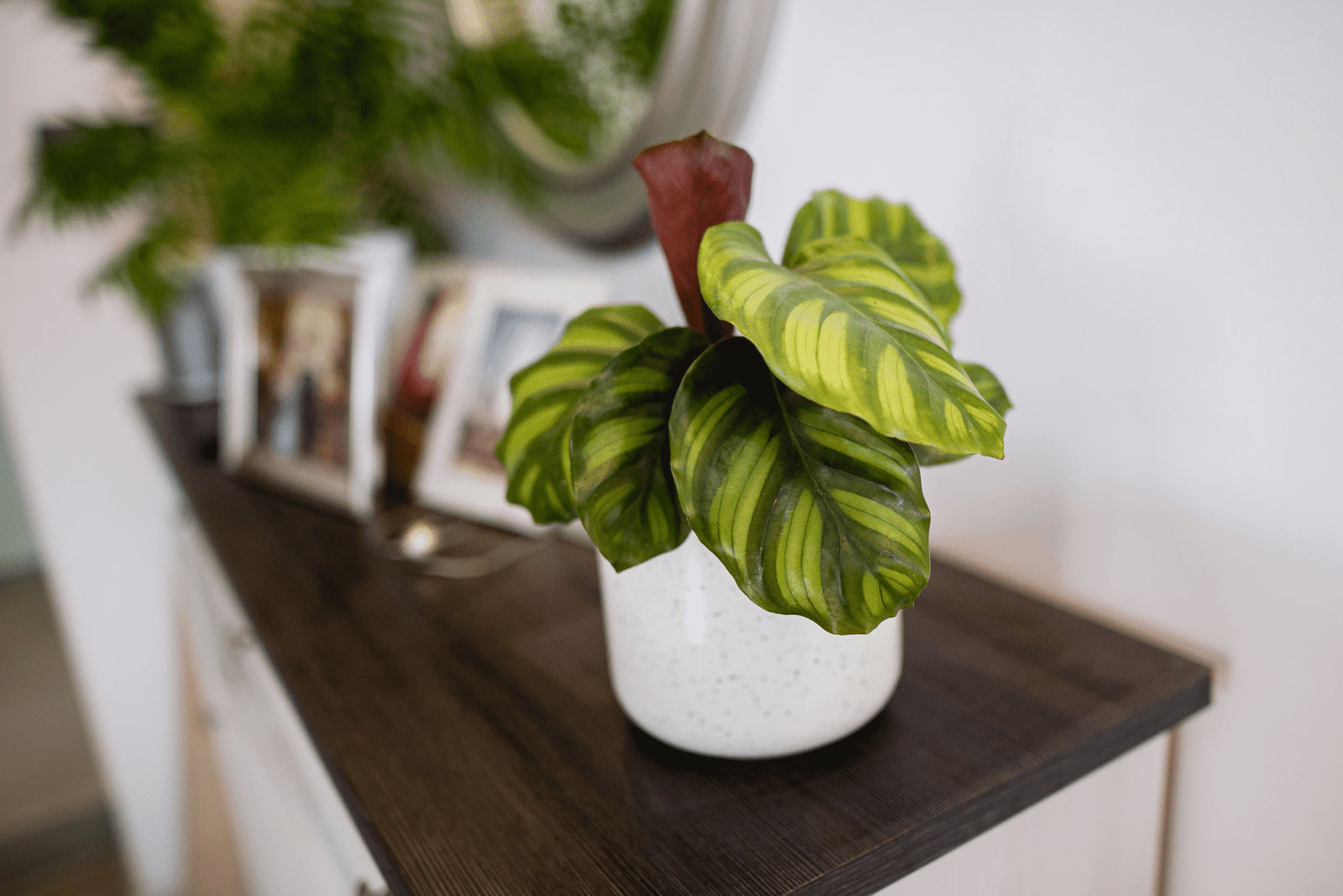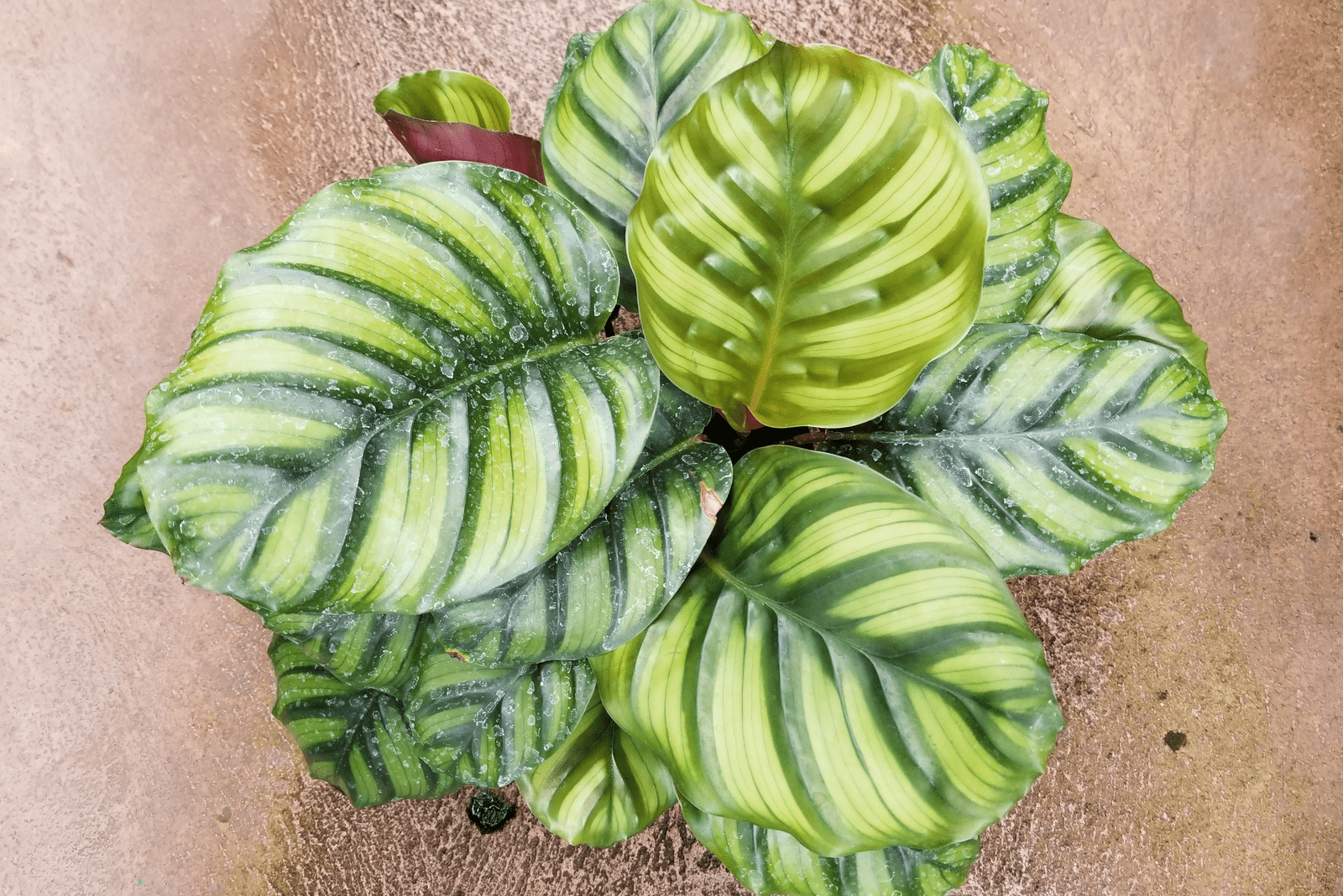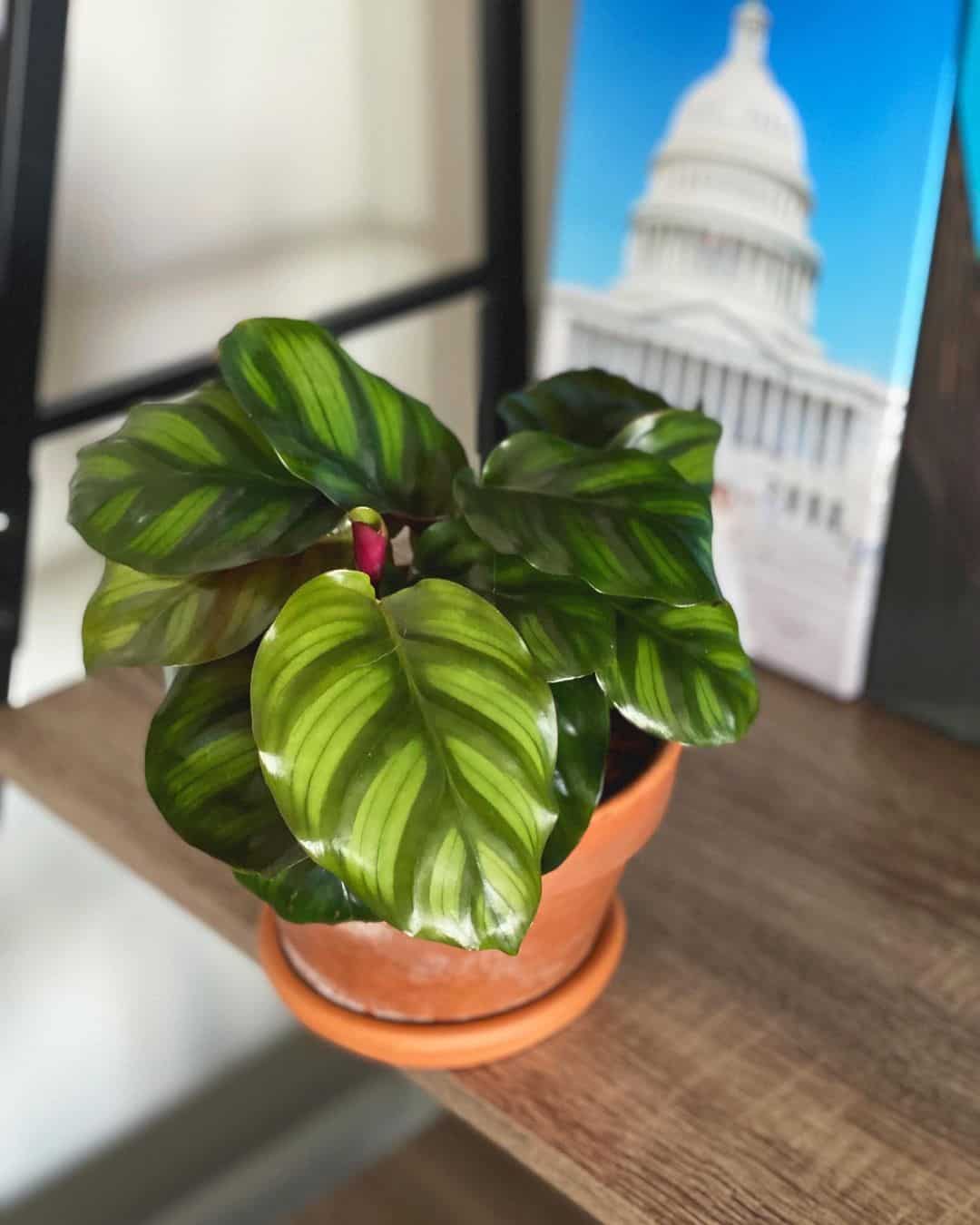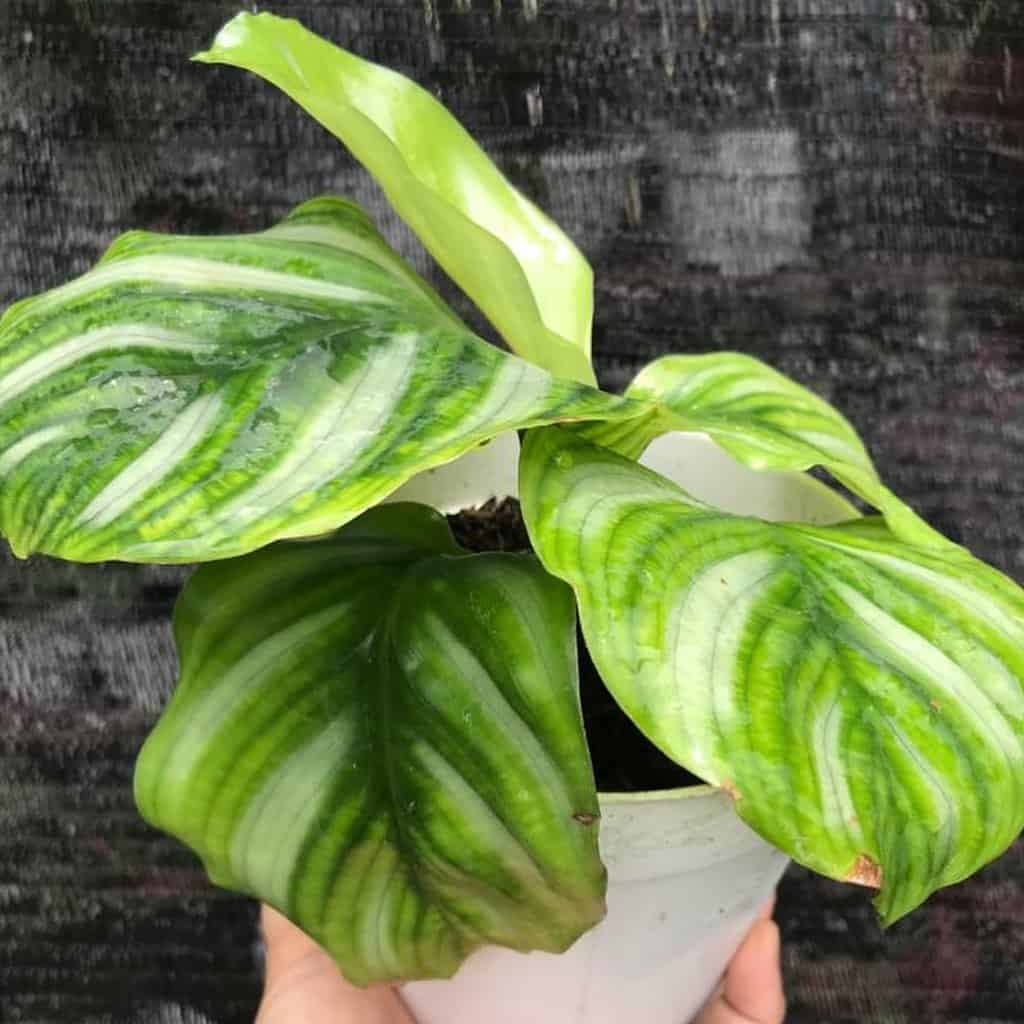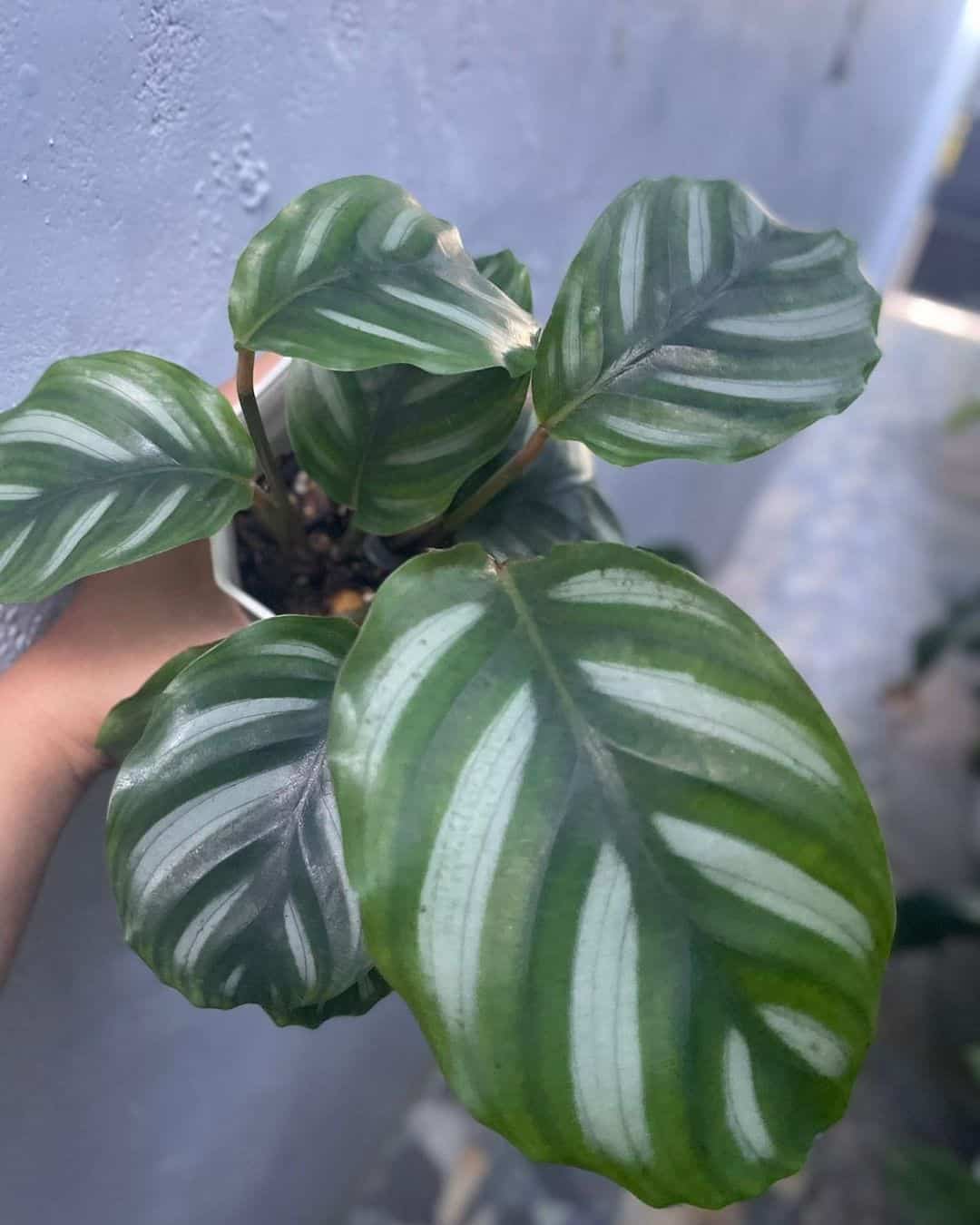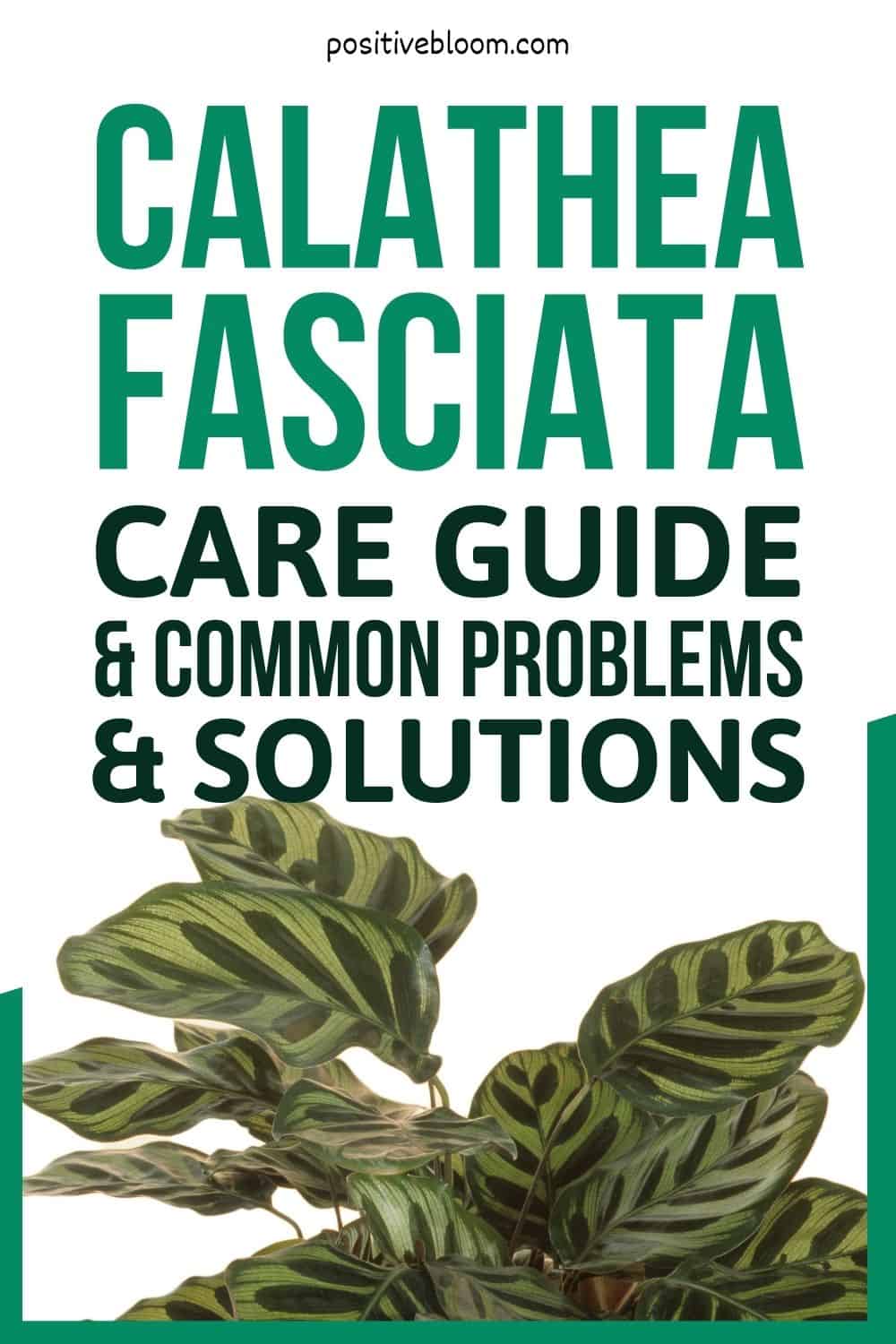Here is yet another delightful indoor plant that has become quite popular among plant collectors (seriously, it’s been sold out for forever!).
This high in demand Calathea plant has glossy, compact dark and light green stripes on the leaves, with a contrasting purple color on the underneath. The leaves are special because of their unique patterns, as well as the eye-catching veins protruding along the leaves’ surfaces, which make them truly mesmerizing!
The Calathea Fasciata is an exotic plant that is native to America, and it belongs to the Marantaceae family, which has about 300 different species. Here is a detailed classification of the Calathea Fasciata:
[table id=129 /]It is important to note that there have been changes when it comes to its classification: they were previously considered to be a part of the Rotundifolia genus, however, it was determined that they are a different species; the same goes for the Calathea Orbifolia and Calathea Variegata, they are often mistaken for one another due to the astonishing resemblance between them!
Nonetheless, your Calathea Fasciata will look great together with your Alocasia, Aglaonema, Philodendron, and Peacock plant!
If you want this houseplant to decorate your home or garden, then checkout its growing habits and care guide!
How To Grow The Calathea Fasciata
The Calathea Fasciata can be quite tricky to deal with; it has strange requirements that can sometimes be hard to manage, but I am sure that every plant enthusiast will be able to get the hang of it!
First, let’s discuss its growth habits before going into the care guide.
Calathea Fasciata Growth Habits
The Calathea Fasciata is a tropical plant that can be grown both outdoors and indoors. It is a fast-growing plant which has to be repotted frequently.
It grows between 7 and 25 inches tall, though it is able to grow to about 30 inches high if it has enough space. The approximate size of the leaves is 3 inches long and 2 inches wide. The leaves are absolutely adorable!
The Calathea Fasciata uses rhizomes for its growth; you don’t have to worry, they are not invasive and you won’t have to worry about them spreading all over your garden!
Another positive thing about this beautiful plant is that it is not toxic: You won’t have to keep your pets and little kids away from a Calathea Fasciata, it is perfectly safe!
How To Plant The Calathea Fasciata
If you are planning to plant this Calathea prayer plant, you will have to prepare the soil first. You should use a pest free, commercial potting mix that is also well-draining. Make sure to plant it in a container with drainage holes at the bottom, as they are necessary for excess water removal.
Fill the pot 2 inches with the soil, then create a hole with a trowel, or use your hand if you don’t mind getting a little dirty.
Then, put the plant into the hole and cover the root ball with the rest of the soil. You can also press down slightly to compress it.
Potted plants should be watered thoroughly to let the soil settle and provide enough moisture for new development. Bear in mind that the standard USDA zone ranges from 9 to 11.
How To Take Care Of A Calathea Fasciata
Photo from :@je.seed
But don’t worry, you’ve got this!
Just follow the instructions below, and your exotic prayer plant will be happy and healthy.
Water Requirements
We are starting with the toughest part of the care guide, which is the watering. We know that Calathea Fasciata are tropical plants, and those are really thirsty — yet, we can not just pour water into the soil continuously without letting it have a break.
So yeah, it can be hard to determine how much water your Calathea Fasciata needs.
Overall, they like to have moist soil, not soggy though as this can lead to root rot that is followed by numerous other problems. However, you should let the top of the soil dry out before watering it again — this is the easiest way for you to determine your watering schedule.
Another thing that you have to take into consideration is the type of water that you are using: these plants are incredibly sensitive, and they are easily harmed by any compounds and minerals that are found in tap water. For instance, the leaves might start turning brown if there is a high concentration of salt, fluoride, or chlorine.
I would suggest that you use filtered water instead, to provide your plant with the absolute best care ever!
When watering, water the soil thoroughly and avoid watering the leaves, as this can easily attract pests and fungus that could cause many diseases in your precious plant.
Soil Requirements
As we have previously mentioned, the plant likes to have soil that will retain moisture, so the best one to use would be a well-draining soil. There aren’t any special requirements like the watering; simply buy a commercial potting soil and follow the instructions to get optimum results.
Light Requirements
When it comes to light requirements, this plant is not too picky and can easily adapt to different light conditions (anything moderate).
The Calathea Fasciata prefers growing in bright indirect light to partial shade. Remember that they are tropical plants, so they are always growing in shade below big trees and different plants in their natural habitats — and the best way that you can provide your plant with the best care is to mimic its natural environment.
This light versatility is what makes it a great indoor plant, as many houseplants tend to grow only in bright or direct sunlight.
Actually, you should avoid exposing this plant to direct sunlight as it can burn its leaves, which affects those pretty colors and patterns and you might end up with crusty, brown leaves.
I suggest that you rotate your plant every once in a while so that every part of it can get enough light for the healthiest growth.
Temperature Requirements
Tropical plants do love warmer temperatures — this applies to your Calathea Fasciata as well! They will thrive in temperatures that range from 50 to 85 degrees Fahrenheit, anything below or above might harm your plant.
During the colder seasons, make sure to avoid placing them near windows or doors, as it can get drafty — this applies to the air conditioning during the warm seasons as well.
Fertilizer Requirements
The Calathea Fasciata is a low maintenance plant when it comes to fertilizing. They are not heavy feeders, thus, they won’t be requiring constant fertilizing.
The best idea is to add fertilizers during the growing season to promote the growth of new leaves and blooms (because your Calathea Fasciata is still a flowering plant), and you should use a slow-release fertilizer or a complete liquid fertilizer.
Humidity Requirements
The Calathea fasciata is very specific when it comes to its humidity needs: it absolutely loves a high humidity and must have at least 50% or higher humidity levels. So, what to do if you live in an area with low humidity?
Since you are growing your Calathea Fasciata indoors, humidity is not a problem that can’t be solved… on the contrary, you can do various different things to boost the humidity level in your house.
You can either buy a humidifier (not the cheapest, but the most effective option for sure); the cheapest option is to place a bowl of water near the plant, however this is not as effective
The creative option is to make a pebble tray to sit underneath the plant to increase the moisture, and you can also mist your plant during the warm season.
Pruning
I know it can be hard to prune those beautiful leaves, but one must do it to keep the plant healthy and tidy — especially if the leaves are damaged or infected. The reason why pruning is a necessity is because it prevents excessive root growth that would probably require a larger pot after a while.
Nonetheless, your plants will love frequent pruning because they look neat and tidy after each leaf-cut!
Repotting
It is unlikely for a Calathea Fasciata to be repotted because they are constantly pruned; however, if you missed a pruning or two, the roots might develop and require a larger pot.
No worries, you can easily repot your Calathea Fasciata!
The most optimal time to do so is in early spring, before the intense development during the growing season. Make sure to water it thoroughly a day before repotting, to soften the soil and make your job a bit easier.
Go and buy a larger pot with a drainage hole at the bottom and prepare the soil; carefully take your plant, without damaging the root ball and place it in the new pot and voila! You have successfully repotted your precious plant!
Propagation
Propagation is surprisingly not that difficult with the Calathea Fasciata! They expand and grow by rhizomes, which are used for propagation. The best time for propagation is in early spring or summer.
Before propagation, make sure that the mother plant is healthy; if not, you might encounter stunted growth or no growth at all. Follow the instructions below for a successful propagation:
1. Keep those little rhizomes in a moist and warm place — this affects the growth of your new baby plant.
2. Prepare the appropriate soil for this plant (this also applies to the pot).
3. Sow the rhizome and cover your pot with a plastic sheet to retain warmth and moisture.
4. Put your new plant in a place with low light, avoid full sun exposure.
Common Problems With The Calathea Fasciata
Photo from@deliensgallery
The not so fun part about taking care of this plant is the problems with the leaves. Yep, you can buy a Calathea Fasciata mainly because of its pretty leaves, just to end up with them turning yellow or curling. Such a shame!
Here, we will cover some problems that you might have to deal with when growing your Calathea Fasciata plant.
Root Rot
Remember when we said that the watering part might be the trickiest when compared to all the other requirements? Well, the reason is root rot.
Excessive moisture of the soil can lead to root rot, which is caused by bacterial or fungus infections. If the roots are smelly, then this is the case and you will probably have to uproot your plant.
If you notice that the stems have started rotting, then you should probably say goodbye to your Calathea Fasciata.
Always check the roots first as they influence the overall health of your plant.
Leaves Changing Color
A Calathea Fasciata might end up losing its pretty leaf colors, and many factors can actually be the reasons why this happens. First, let’s look into the different colors of leaves and figure out what might be the issue.
Leaves Turning Brown
You might notice the tips of the Calathea Fasciata leaves turning brown; the main reason for this might be low humidity levels. Other factors like underwatering, overwatering, tap water and sunburn might also be the cause.
As we have mentioned in the care guide, your Calathea Fasciata loves moist soil but you should let the top of the soil dry out; however, if you leave it without water for too long, the edges of the leaves might change to brown.
Maybe you have perfected the watering schedule, but you might have used tap water that is filled with salts and minerals. High salt concentration in the soil can lead to brown leaf tips. Use filtered or distilled water instead.
This plant prefers growing in indirect light, and exposing it to direct sunlight for a long time can lead to the leaves turning brown and crispy.
Leaves Turning Yellow
If the leaves start turning yellow, they do it fast. If you don’t act immediately and try to figure out what might be the issue, you could lose your beloved plant.
Yellow leaves are usually an indicator of watering and fertilizing issues, too much exposure to direct sunlight, or it might be natural shedding.
Over watering is a common issue with this plant — you should provide your plant with well-draining soil and a pot with drainage holes; if the leaves start turning yellow, then you should water it less and put it in a place with more light.
Fertilizing issues might be due to over fertilizing (in this case, flush the soil with distilled water), or due to the lack of nutrients and fertilizing. They are not heavy feeders, though you should provide it with some plant food.
Natural shedding depends on the plant’s mood: if it has been repotted recently, then some of the leaves might turn yellow and drop off, or it can naturally happen when the plant reabsorbs the nutrients from lower leaves as it grows.
Pattern Loss
The main reasons why the leaves lose their unique patterns and become less variegated are inadequate lighting and nutrient deficiency.
If you put your Calathea Fasciata in a place with too much light, the leaves are going to start looking much more faded or even translucent; move your plant away from the window and into an area with lower light.
But, not too low though, as this can also lead to pattern loss. Too little light can lead to your leaves looking faded. Not enough nutrients might also be the causative, so get your plant some plant food immediately!
Leaves Changing Structure
You are used to looking at those round, perfectly shaped leaves all day — and now they have started curling and drooping. Ahhh the pain… I know! It can be really disappointing to spend so much time on a plant, just to end up with a droopy one.
Don’t worry, this can be fixed and your plant can still produce those beautiful leaves!
Let’s dive in.
Curling Leaves
Leaves might start curling inwards or outwards and this can be caused by water stress, or the plant is simply irritable and starts acting up.
If the soil is completely dried out, and you haven’t been watering your plant as much, then the issue might be underwatering. However, if you have been watering your Calathea Fasciata but the leaves are curling and wilting, then the issue might be overwatering.
If the latter one is the issue, then you should check the plant for root rot; but if the issue is underwatering, simply water more frequently and thoroughly.
Too compact soil might be an issue as well, since there is no space for air circulation; this can be easily fixed by poking small holes in the soil.
Droopy Leaves
Mediate drooping might be normal during the day because they are prayer plants that have special movements during the day and night. If you notice significant drooping, then the issue might be inadequate watering, just like in the case of curling leaves, or the temperature is lower than the optimal one.
Remember that they are tropical plants, and they are not used to low temperatures! Don’t put them near drafty windows, especially during colder seasons, and put them far away from the air conditioning during summer.
Pest Infestations
Spots underneath and on the leaves, discoloration and browning might be indicators that your plant has been under attack, and the invaders are annoying pests and insects.
The Calathea Fasciata is susceptible to scales, spider mites, mealybugs, and fungus gnats.
These microscopic creatures can be hard to detect, but if you take a look at your plant more closely, you might notice different features characteristic for certain pest types.
For instance, if you notice anything sticky on your plant, then you might be dealing with scales, as they extract sticky honeydew that attracts ants.
The plant starts acting up during winter? Then it has probably been visited by spider mites, because they usually infest the plants during colder seasons — leaf showers and increasing humidity levels might prevent them from invading.
Spots on the leaves indicate mealybugs presence, as they tend to hide in leaves and steal all the yummy nutrients from your plant! It would be best if you used neem oil or insecticides to get rid of them.
If the soil is constantly soggy, then fungus gnats might pop up out of nowhere and start eating the roots of your plant. If this is the case, then leave the soil to dry out or mix water with hydrogen peroxide and apply.
For more information about problems and common mistakes when growing Calathea, click on this video:
Frequently Asked Questions
1. Why are they called prayer plants?
These plants are also known as prayer plants because of their special movement, called nyctinasty.
This movement is associated with changing from night to day and vice versa: when there is darkness outside, the leaves of these plants are closed — it’s like the leaves are the eyes of the plants that are closed during the night and sleeping!
When the morning comes, the leaves open again and they will remain open until the evening.
2. What is the difference between the Calathea Fasciata and Calathea Rotundifolia?
Both the C. Fasciata and C. Rotundifolia are members of the same family, and it can be hard to distinguish one from the other due to the remarkable resemblance!
However if you take a close look at the leaves, you can see that the Calathea Rotundifolia has larger and much more compact leaves than the Calathea Fasciata, and that the patterns are brighter as well!
The Calathea Rotundifolia has much more prominent green leaves, while the Calathea Fasciata has dark green leaves with purple undersides. Asides from this, they are the same plant and have similar requirements.
3. What are the insect pests that affect the Calathea?
The Calathea is susceptible to pests such as mealybugs, spider mites and scales, as well as fungus gnats. If you notice any discolorations and spots on the leaves, then you are probably dealing with mealybugs.
Scales tend to produce honeydew that is sticky on stems, and fungus gnats tend to appear in soggy soil and eat up the plants’ roots!
Spider mites love winter and they attack in the colder season, so if you notice anything different (negatively) in your plant at this time, then you are probably dealing with spider mites.
4. Are calathea toxic to humans?
No, calathea are not toxic to humans! We rarely encounter houseplants that are not toxic, which is the safest option for all plant enthusiasts out there with little kids and pets. You won’t be worrying all the time about anyone accidentally eating your Calathea because nothing bad can happen.
Final Thoughts
Although the Calathea Fasciata requires special care, I think it is absolutely worth growing it — you don’t see leaves closing in the night and opening back again in the morning in every other houseplant!
Bear in mind that the watering is the trickiest part of the care guide, and know that your plant can not tolerate water stress, so it is important to maintain the right watering schedule from the beginning.
If you don’t, then you will end up having to save your plant from different kinds of issues… but this can be done!
Remember that the leaves changing colors and structures is primarily caused by inadequate watering, and that your plant is susceptible to different pest infestations.
You got this, I believe in you!
Like this post? Share or pin it for later!

